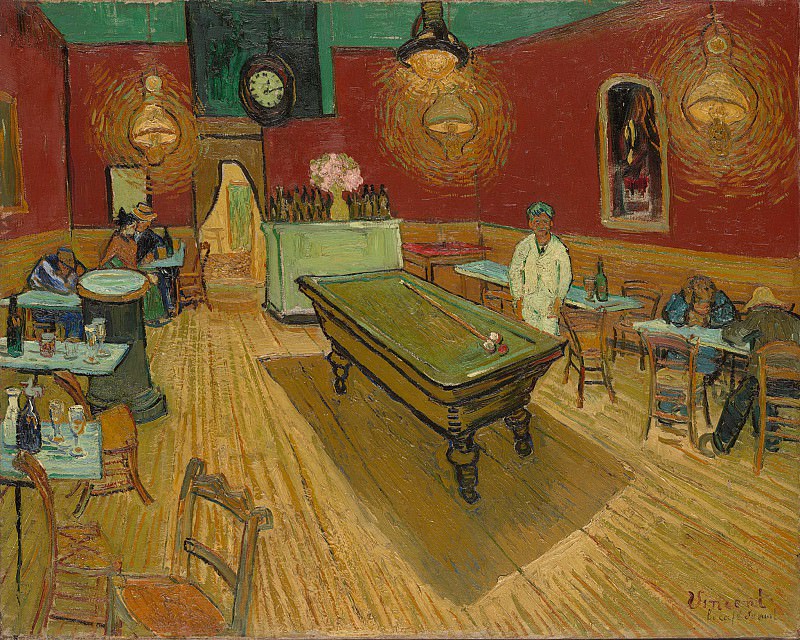NIght Cafe Vincent van Gogh (1853-1890)
Vincent van Gogh – NIght Cafe
Edit attribution
Download full size: 2045×1636 px (0,6 Mb)
Painter: Vincent van Gogh
Location: Yale University Art Gallery, New Haven.
The painting Night Café was painted by the artists in September 1888. For three nights Vincent van Gogh visited a station café in the city of Arles in the south of France, observing night-time patrons aimlessly spending their time drinking. The blurred lines, sloppy brushstrokes, and blurred faces of the cafe’s patrons suggest the author’s desire to convey the state of an unsober person. The interior of the room is filled with a mass of nuances which, contrasting with each other, convey the depressive state of the artist.
Description of Vincent van Gogh’s painting "Night Café"
The painting Night Café was painted by the artists in September 1888.
For three nights Vincent van Gogh visited a station café in the city of Arles in the south of France, observing night-time patrons aimlessly spending their time drinking.
The blurred lines, sloppy brushstrokes, and blurred faces of the cafe’s patrons suggest the author’s desire to convey the state of an unsober person.
The interior of the room is filled with a mass of nuances which, contrasting with each other, convey the depressive state of the artist. The green color of the ceiling speaks more of a sense of morbidity exacerbated by the disturbing red walls, and the abundance of warm tones of yellow adds to the stuffy and smoky atmosphere of the place. An abandoned billiard table, a large number of bottles and empty glasses on vacant tables further emphasize the abandonment and unnecessaryness.
The night time is emphasized by the clock which shows that it is well past midnight, the night landscape in the window, four brightly lit lamps and a lingering couple at the corner table at the entrance.
A drowsy visitor and two people who have been drinking heavily add to the oppressive impression. And the effect is completed by a visitor in a yellow suit looking either directly at the artist or directly into the viewer’s eyes.
The artist wrote to his brother Theo that in this painting he was trying to convey a setting and a pernicious passion in which the self-destruction of man, where he goes mad or becomes a criminal.
This painting was critically acclaimed and was hailed as one of Van Gogh’s masterpieces. It later gave birth to a new style - expressionism.
The artist would later repeat it in watercolor.
Today, the painting Night Café is kept in the Yale University Art Gallery.
Кому понравилось
Пожалуйста, подождите
На эту операцию может потребоваться несколько секунд.
Информация появится в новом окне,
если открытие новых окон не запрещено в настройках вашего браузера.
You need to login
Для работы с коллекциями – пожалуйста, войдите в аккаунт (open in new window).




















You cannot comment Why?
On the left, two figures are seated at a table, appearing withdrawn, possibly engaged in a quiet conversation or lost in their own thoughts. Towards the back, a bar area is visible, with bottles lining the shelves and a vase of pale pink flowers, a small, delicate touch amidst the otherwise harsh environment. A clock on the wall indicates the passage of time. In the middle right of the painting, a man in a light-colored uniform, likely the cafe attendant, stands near the pool table, seemingly observing the scene or waiting for patrons. Further to the right, two more figures slump at a table, one with his head buried in his arms, suggesting weariness, sadness, or despondency. The floor, rendered in shades of yellow and brown, shows strong directional brushstrokes, indicating the slant of light and creating a sense of depth.
The subtexts of The Night Cafe are rich and evocative. Van Gogh himself described the painting as an attempt to express the terrible passions of humanity by means of red and green. The oppressive, vibrant red walls, combined with the acidic green ceiling, create a sense of unease and emotional intensity, almost as if the very atmosphere is charged with anxiety. The harsh, unnatural yellow light can be interpreted as symbolizing the artificiality and superficiality of the environment, or perhaps a distorted, feverish state of mind. The isolated and slumped figures suggest themes of loneliness, despair, and the alienation that can be experienced even in a public space. The cafe, usually a place of social gathering, is here transformed into a site of individual suffering and quiet desperation. The contrast between the bright light of the lamps and the deep shadows further emphasizes the dramatic and emotional tenor of the scene. Van Gogh aimed to capture the feeling of a place where one could ruin oneself, go mad, or commit a crime, a place where the inhabitants are lying on the floors, more or less dead.